
A fire engine is a road vehicle that functions as a firefighting apparatus. The primary purposes of a fire engine include transporting firefighters and water to an incident as well as carrying equipment for firefighting operations in a fire drill. Some fire engines have specialized functions, such as wildfire suppression and aircraft rescue and firefighting, and may also carry equipment for technical rescue.
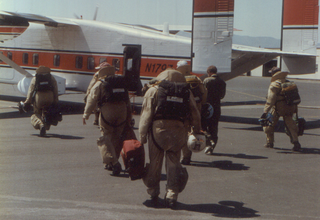
Smokejumpers are specially trained wildland firefighters who provide an initial attack response on remote wildland fires. They are inserted at the site of the fire by parachute.

A helicopter bucket or helibucket is a specialized bucket suspended on a cable carried by a helicopter to deliver water for aerial firefighting. The design of the buckets allows the helicopter to hover over a water source—such as a lake, river, pond, or tank—and lower the bucket into the water to refill it. This allows the helicopter crew to operate the bucket in remote locations without the need to return to a permanent operating base, reducing the time between successive drops.
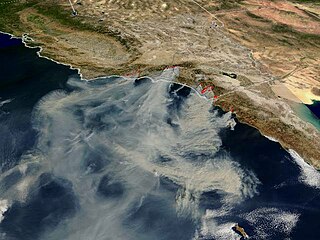
The Cedar Fire was a massive, highly-destructive wildfire, which burned 273,246 acres (1,106 km2) of land in San Diego County, California, during October and November 2003. The fire's rapid growth was driven by the Santa Ana wind, causing the fire to spread at a rate of 3,600 acres (15 km2) per hour. By the time the fire was fully contained on November 4, it had destroyed 2,820 buildings and killed 15 people, including one firefighter. Hotspots continued to burn within the Cedar Fire's perimeter until December 5, 2003, when the fire was fully brought under control.

Aerial firefighting, also known as waterbombing, is the use of aircraft and other aerial resources to combat wildfires. The types of aircraft used include fixed-wing aircraft and helicopters. Smokejumpers and rappellers are also classified as aerial firefighters, delivered to the fire by parachute from a variety of fixed-wing aircraft, or rappelling from helicopters. Chemicals used to fight fires may include water, water enhancers such as foams and gels, and specially formulated fire retardants such as Phos-Chek.
Firefighting jargon includes a diverse lexicon of both common and idiosyncratic terms. One problem that exists in trying to create a list such as this is that much of the terminology used by a particular department is specifically defined in their particular standing operating procedures, such that two departments may have completely different terms for the same thing. For example, depending on whom one asks, a safety team may be referred to as a standby, a RIT or RIG or RIC, or a FAST. Furthermore, a department may change a definition within its SOP, such that one year it may be RIT, and the next RIG or RIC.
This glossary of wildfire terms is a list of definitions of terms and concepts relevant to wildfires and wildland firefighting. Except where noted, terms have largely been sourced from a 1998 Fireline Handbook transcribed for a Conflict 21 counter-terrorism studies website by the Air National Guard.

A fire retardant is a substance that is used to slow down or stop the spread of fire or reduce its intensity. This is commonly accomplished by chemical reactions that reduce the flammability of fuels or delay their combustion. Fire retardants may also cool the fuel through physical action or endothermic chemical reactions. Fire retardants are available as powder, to be mixed with water, as fire-fighting foams and fire-retardant gels. Fire retardants are also available as coatings or sprays to be applied to an object.
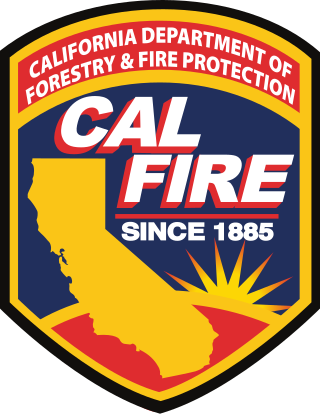
The California Department of Forestry and Fire Protection is the fire department of the California Natural Resources Agency in the U.S. state of California. It is responsible for fire protection in various areas under state responsibility totaling 31 million acres, as well as the administration of the state's private and public forests. In addition, the department provides varied emergency services in 36 of the state's 58 counties via contracts with local governments. The department's current director is Joe Tyler, who was appointed March 4, 2022, by Governor of California Gavin Newsom.

In the United States, a Shot Crew, officially known as an Interagency Hotshot Crew (IHC), is a team of 20-22 elite wildland firefighters that mainly respond to large, high-priority fires across the country and abroad. They are assigned to work the most challenging parts of the fire and are considered strategic and tactical wildland fire experts. Hotshots are a national resource and their deployment is controlled at the national level. Hotshot crews are considered the most highly trained, skilled and experienced wildland firefighters, along with smokejumpers. They are qualified to provide leadership for initial-attack and extended-attack on wildland fires. Hotshots are trained and equipped to work in remote areas for extended periods of time with minimal logistical support. They are organized by agencies such as the United States Forest Service, National Park Service, Bureau of Indian Affairs, Bureau of Land Management, and state/county agencies; the National Interagency Fire Center coordinates hotshot crews on the federal level.
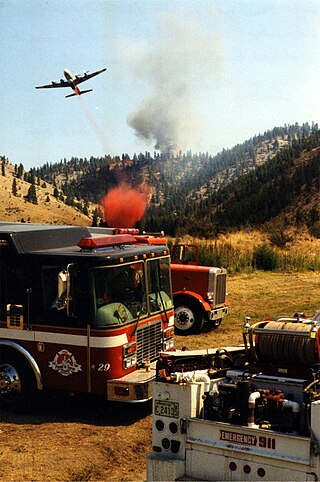
Wildfire suppression is a range of firefighting tactics used to suppress wildfires. Firefighting efforts in wild land areas require different techniques, equipment, and training from the more familiar structure fire fighting found in populated areas. Working in conjunction with specially designed aerial firefighting aircraft, these wildfire-trained crews suppress flames, construct fire lines, and extinguish flames and areas of heat to protect resources and natural wilderness. Wildfire suppression also addresses the issues of the wildland–urban interface, where populated areas border with wild land areas.

The National Interagency Fire Center(NIFC) in Boise, Idaho is the American physical facility which is the home to the National Interagency Coordination Center (NICC), and the National Multi-Agency Coordination group (NMAC or MAC).

A fire camp is a campsite for firefighters and support personnel. It is typically set up for a large project fire which requires a large amount of manpower, organisation and logistics. According to the National Incident Management System (NIMS), a fire camp is one of five predesignated temporary facilities. Fire camps provide certain essential auxiliary forms of support, such as food, sleeping areas, and sanitation for Wildland firefighters. Fire camps may also provide minor maintenance and servicing of equipment.
The CAL FIRE Aviation Management Program is a branch of the California Department of Forestry and Fire Protection. Due to the frequency and severity of wildfires in California, the state has elected to establish its own aerial firefighting force rather than rely solely on national resources. The Aviation Management Program is based at McClellan Airfield near Sacramento, California.

The Modular Airborne FireFighting System (MAFFS) is a self-contained unit used for aerial firefighting that can be loaded onto both military cargo transport Lockheed C-130 Hercules and Embraer C-390 Millennium, which then allows the aircraft to be used as an air tanker against wildfires. This allows the U.S. Forest Service (USFS) to use military aircraft from the Air National Guard and Air Force Reserve to serve as an emergency backup resource to the civilian air tanker fleet.
Howard Forest Station is a CAL Fire station and emergency command center (ECC) in Mendocino County, California, located along U.S. Route 101 and 5 miles (8 km) south of the city of Willits. The Howard Forest ECC serves as a secondary public safety answering point (PSAP) for fire and emergency medical services in largely unincorporated Mendocino County. The compound is also the location of the Howard Forest Helitack Base and serves as the headquarters of the Mendocino Ranger Unit.
Wildfire suppression equipment and personnel is part of the science of fire fighting focusing on the use of specialized equipment, training and tactics to effectively control, surround and eventually extinguish a natural cover fire. There are several specially designed tools that through their function and user training, perform specialized tasks that are specific to natural cover firefighting. This is used together in conjunction with the general understanding of the behavior of fire to form a viable plan of attack.

On August 18, 1937, a lightning strike started the Blackwater Fire in Shoshone National Forest, approximately 35 miles (56 km) west of Cody, Wyoming, United States. Fifteen firefighters were killed by the forest fire when a dry weather front caused the winds to suddenly increase and change direction. The fire quickly spread into dense forest, creating spot fires that trapped some of the firefighters in a firestorm. Nine firefighters died during the fire and six more died shortly thereafter from severe burns and respiratory complications. Another 38 firefighters were injured. The fire killed more professional wildland firefighters in the U.S. than any other in the 103 years between the Great Fire of 1910 and the Yarnell Hill Fire in 2013.
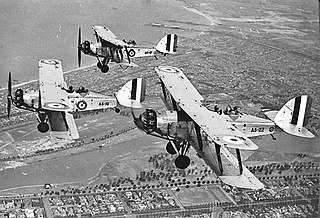
The development of aerial firefighting and forestry in southern Australia ran in parallel with the rapid improvements in aircraft technology over the last century. As more advanced and capable aircraft became available firefighters and foresters quickly sought opportunities to utilise and adapt them.

The Flathead Hotshots are a U.S. Forest Service interagency hotshot crew located in the Hungry Horse Ranger District of the Flathead National Forest in Hungry Horse, Montana.
































